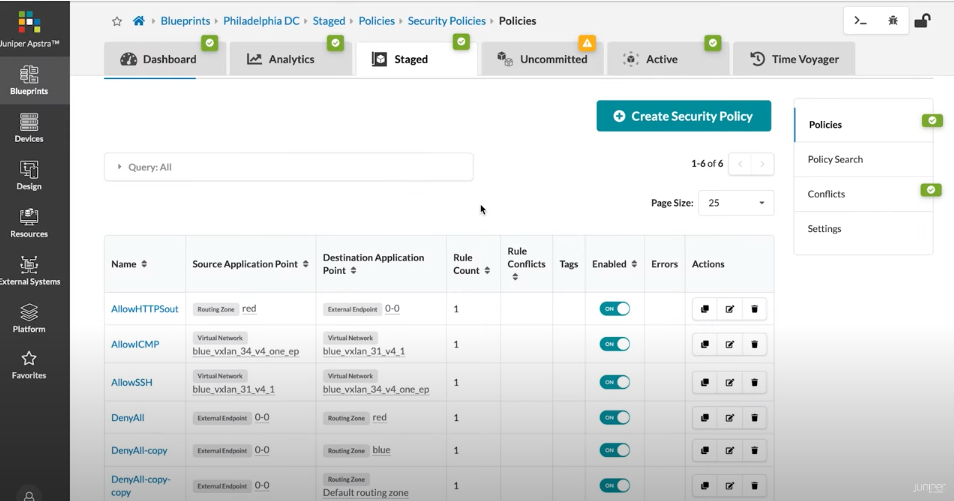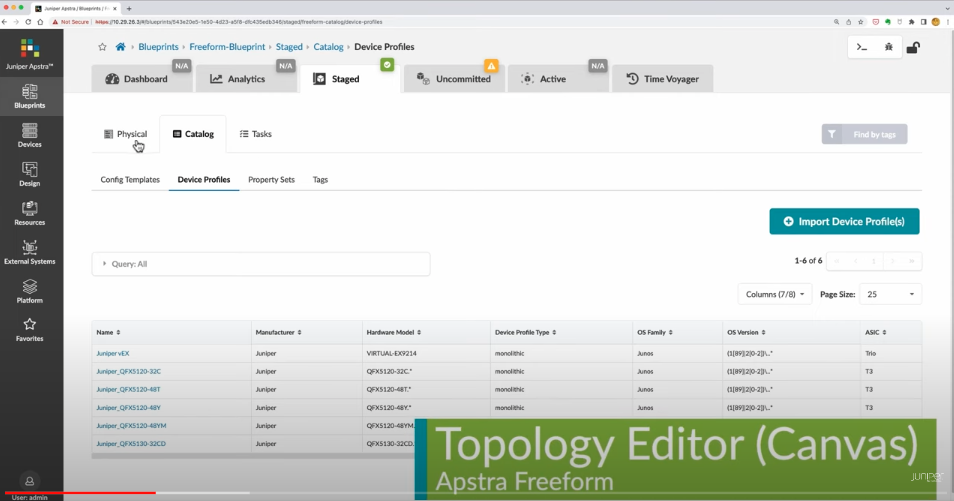From the datacentre to the edge


Service providers, how will you stay competitive in a cloud-first world?
In this episode of “The Power of Open” on TelecomTV, Juniper’s James Kelly and Ali Kafel of Red Hat discuss how service providers can –– and must –– simplify complex architectures, manage applications across a distributed cloud, and automate everything in order to successfully manage cloud-native applications.
You’ll learn
Key ways service providers are improving operational economics today
How Red Hat and Juniper are working together to enable service providers to build agile, scale-out telco infrastructures
Who is this for?
Host

Guest speakers


Transcript
0:04 foreign
0:13 a series of programs covering red Hat's
0:16 open ecosystem where we talk with some
0:18 of red Hat's key Partners to discuss the
0:21 pressing topics in the industry I'm Guy
0:24 Daniels director of content at Telecom
0:26 TV and in this show we're going to look
0:28 at the network from the data center to
0:31 the edge
0:33 and joining me today are Ali cartel who
0:36 is senior director Global isvs and oems
0:39 tme vertical at Red Hat
0:42 at James Kelly senior director of
0:45 product management at Juniper Networks
0:47 Hello both of you thanks so much for
0:50 taking part in our program today
0:52 let me start by asking you James what
0:54 are the key trends that you are seeing
0:56 in how service providers are increasing
0:59 their operational economics how does
1:02 open development factor in
1:04 yeah guy what service providers are
1:08 dealing with today to improve
1:10 operational economics are a lot more
1:12 Partnerships
1:13 um one of the things that's especially
1:15 pronounced now in in the changing
1:17 landscape of Partnerships is partnering
1:20 with the hyperscalers right the likes of
1:22 the large Cloud providers in other words
1:24 for hybrid Cloud infrastructure
1:27 obviously taking a page of hybrid and
1:29 multi-cloud popularity out of the
1:30 Enterprise and using the flexibility
1:32 that that brings
1:33 another thing that we continue to see a
1:36 strong development of as they build out
1:38 their their 5G their Telco Cloud
1:41 infrastructures are strong Partnerships
1:43 with the global system integrators right
1:48 this provides the opportunity for more
1:50 flexibility
1:53 um for example as they can pick and
1:56 choose and have the system integrator
1:58 integrate the best parts for the
2:00 solution Taylor Made for them as opposed
2:03 to just a contrast of like a vertical uh
2:07 stack a vertical telephony stack
2:10 to give some other examples outside of
2:12 Partnerships I mean choosing tools
2:14 products from the vendors that addressed
2:17 one to many management whether that's
2:20 one to many use cases like for example
2:24 you know junipers cn2 Cloud native
2:27 control networking product that
2:28 addresses both kubernetes openshift and
2:31 openstack so multiple things there that
2:34 kind of span new and old so to speak and
2:38 multi-cluster management right nobody
2:40 has just one deployment area they have
2:44 many I'm sure we'll talk more about that
2:46 but that's another thing that uh Juniper
2:49 has emphasized in our products uh and
2:51 then getting into the the other part of
2:53 your question around open right
2:55 um
2:56 certainly choosing uh kubernetes
3:00 openshift open source and Open Standards
3:03 based things I mean we can talk a lot
3:05 about uh about open source but the the
3:10 resiliency of using a system like
3:13 kubernetes these days to deploy
3:15 microservice based applications leads to
3:17 obviously increased elasticity kind of
3:20 one of the things that containerized
3:22 applications are famous for and as the
3:26 telephony application vendors move from
3:28 virtual Network functions to
3:29 containerized network functions that run
3:31 in in systems like openshift that
3:34 obviously gives them not just increased
3:36 resiliency but the increased business
3:38 agility along with it
3:40 and Ali what are the key ways that red
3:43 hat and Juniper are supporting this
3:46 development together
3:48 they're really two ways one is
3:50 indirectly we're working together with
3:52 open source as James mentioned
3:55 um we red hat is is a leader in open
3:59 source communities as as you probably
4:01 know and uh Juniper is is also very
4:04 engaged in the open resource community
4:05 so we work together in advising our
4:08 customers what communities they should
4:11 engage with and should leverage in some
4:13 cases contribute to and then the second
4:16 way is really a more direct way and that
4:19 is in providing pre-integrated Cloud
4:22 infrastructure platform product which is
4:25 a combination of the Juniper cn2 and red
4:30 hat openstack and red hat open shift
4:32 provided as a pre-integrated solution to
4:35 our customer base and what that does is
4:38 it has huge advantages over a vertical
4:42 solution because with a pre-integrated
4:45 horizontal Cloud infrastructure uh
4:47 customers not only get the benefits of a
4:51 horizontal solution such as flexibility
4:54 to choose other vendors of their choice
4:58 and standardize configuration and
5:01 automation no vendor lock-in and so on
5:04 but they also get the unified single
5:08 vendor accountability for SLA and James
5:12 can you add your perspective to this
5:14 collaboration
5:15 yeah sure to add on what Ali was talking
5:18 about I mean Juniper has long since
5:21 worked with red hat
5:23 integrating even before we had cn2 which
5:26 is our Cloud native edition of control
5:27 networking we had the classic edition of
5:30 it we were certified with red hat
5:32 openstack and working to do the same
5:35 with red hat openshift now that cn2 is
5:38 rebased on kubernetes as an extension of
5:40 kubernetes itself it snaps very natively
5:43 into openshift we've
5:46 we worked very early on in the
5:49 architecture of that product to ensure
5:52 that it was going to work very well with
5:54 the openshift installers and that the
5:56 red hat customers would have a good
5:57 customer experience out of the box with
6:00 cn2 we continue to engage in the
6:03 certification program which gives
6:05 customers a lot of confidence that what
6:08 they're getting is very well tested and
6:10 above and beyond that Juniper and red
6:12 hat actually have joint Labs together
6:14 where we have you know our brightest you
6:17 know solution Architects come together
6:19 and test these things out innovate do
6:22 things that we think are going to come
6:23 up in like the next year two years that
6:27 were each Road mapping and try them out
6:29 together
6:30 yeah and James how can providers Drive
6:33 investments in future Telco
6:35 infrastructure whilst at the same time
6:37 maintaining their traditional Networks
6:40 yeah you know telcos for decades have
6:43 been pulling off that Balancing Act of
6:46 as Ali was saying you know digital
6:48 transformation always having a foot in
6:52 trying to modernize while maintain what
6:55 they have as their existing footprint
6:57 one of the things about networks is that
7:00 you know they have to work with the
7:01 existing Brownfield networks so Open
7:04 Standards play a big role there but um
7:07 other than those sort of tried and true
7:09 things that are that are obvious you
7:11 know telcos are also diversifying their
7:14 businesses looking at ways they can
7:16 restructure refocus their business
7:19 with new Investments or even divesting
7:22 from areas or selling them off we talked
7:24 in one of the earlier questions about
7:26 the Partnerships and how the changing
7:28 changing landscape for Partnerships is
7:30 affecting uh telcos and I think that
7:33 insofar as you know straddling the new
7:36 and the old having those Partnerships
7:39 with the hyperscalers and the option to
7:41 use cloud-based infrastructure
7:43 um which is certainly you know relevant
7:45 for the Juniper and red hat openshift
7:49 and and cn2 solution let's look at the
7:52 edge now and where do you see Edge
7:53 Technologies heading in the future and
7:56 what joint plans do you have to better
7:58 enable service providers in this space
8:00 Ali let me ask you this first
8:03 sure yeah so obviously what what
8:07 something well experiencing today is the
8:10 huge amount of data that's going through
8:12 the networks right today we know that 70
8:15 of all traffic is driven by video
8:18 streaming gaming and social media
8:21 um but what we're seeing is the demand
8:24 is not just for you know more data and
8:28 uh you know higher application
8:29 performance but also uh value-added
8:33 services such as you know iot augmented
8:36 reality virtual reality robotics machine
8:40 learning and so on so at Red Hat we
8:43 believe that the edge
8:45 is a way uh for service providers to get
8:49 closer to their customers you know Edge
8:52 is a strategy to develop insights and
8:55 experiences
8:57 uh at the moment that they're needed and
8:59 James where do you see Edge Technologies
9:02 heading look I really like what Ali said
9:06 he said that edge is really a way for
9:09 service providers get closer to the
9:11 customer right and what Juniper has done
9:14 to address Edge is really take some of
9:17 the hardened products and Technologies
9:19 routing Technologies especially that
9:22 have been built for the data center for
9:25 the cloud
9:26 and redefine those as software for
9:29 example containerized software at the
9:32 edge sites and take products like cn2
9:35 that scale very well and make a lot of
9:38 the components optional make it very
9:40 Nimble very lightweight for the resource
9:43 profile of edge data centers for Edge
9:46 Cloud so you know the other things I
9:49 suppose you could say that we're doing
9:51 are investing and making sure that we
9:53 work with the compute such as arm that
9:55 is more popular at Edge sites and as Ali
9:58 touched on Juniper has a big Ambitions
10:01 in the Rick space the the radio
10:03 intelligent controller
10:05 to orchestrate the end-to-end solution
10:09 from The Edge site and as part of the
10:12 Radio Networks all the way back through
10:14 I suppose The Edge sites and back to the
10:16 centralized Topo Cloud centers for
10:18 end-to-end Network slicing well James
10:21 and Ali thank you both very much for
10:22 joining us today
10:25 and to watch additional interviews in
10:28 the power of open series please follow
10:30 the links below this video for now
10:33 though thank you for watching and
10:34 goodbye





